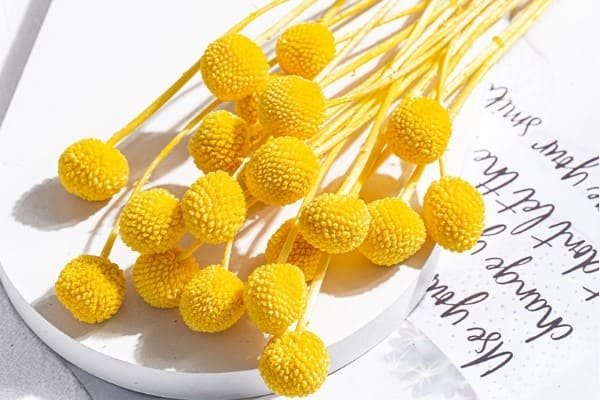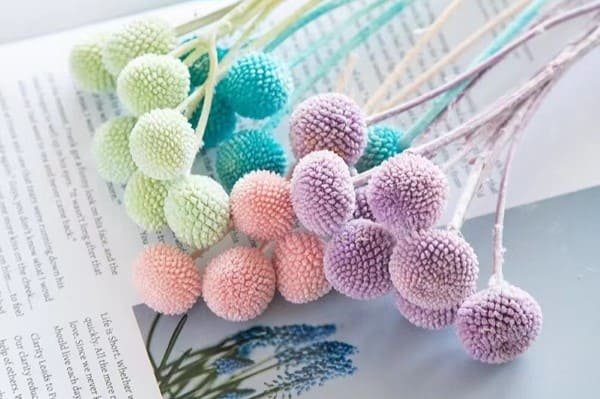Introduction
Dried Craspedia, commonly known as Billy Balls or Drumstick Flowers, have increasingly become a popular choice for floral arrangements, particularly in the context of farm-to-table themes. Their distinctive round, yellow flower heads and long, sturdy stems make them a unique and vibrant addition to various floral designs. This guide explores the role of dried Craspedia in farm-to-table floral arrangements, delving into their characteristics, uses, and the principles behind their integration into such designs.
1. Understanding Dried Craspedia
1.1 Botanical Overview
Craspedia globosa, known for its bright yellow, spherical flower heads, is a member of the Asteraceae family. Native to Australia and New Zealand, this perennial plant produces small, daisy-like flowers that are gathered into a compact, drumstick shape. The dried version retains its shape and color, making it a durable choice for floral arrangements.
1.2 Characteristics of Dried Craspedia
The appeal of dried Craspedia lies in several key characteristics:
- Texture: The spherical flower heads provide a tactile quality that adds interest to arrangements.
- Color: Their vibrant yellow hue remains bold even after drying, offering a pop of color that stands out in mixed floral designs.
- Shape: The round, drumstick shape provides a unique contrast to other floral elements and textures.
2. The Farm-to-Table Concept
2.1 Definition and Principles
The farm-to-table concept emphasizes sourcing food and materials locally, promoting sustainability, and celebrating seasonal produce. In floral design, this approach translates into using locally grown flowers and materials that reflect the seasons and the local landscape.
2.2 Applying Farm-to-Table to Floral Arrangements
Incorporating the farm-to-table ethos into floral arrangements involves:
- Local Sourcing: Using flowers and materials that are grown locally or regionally.
- Seasonal Design: Choosing elements that are in season to reflect the time of year and regional flora.
- Sustainability: Emphasizing eco-friendly practices in the selection and care of floral materials.
3. Dried Craspedia in Farm-to-Table Arrangements
3.1 Sourcing and Harvesting
Sourcing dried Craspedia for farm-to-table arrangements can involve:
- Local Growers: Purchasing from local farmers or specialty growers who produce Craspedia.
- Sustainable Practices: Ensuring that the drying process is done sustainably, without the use of harmful chemicals or excessive waste.
Harvesting Craspedia involves:
- Timing: Picking the flowers when they are fully mature but not yet dry, to ensure they retain their shape and color during the drying process.
- Method: Cutting the stems with care to avoid damaging the flowers, and preparing them for drying either through air drying or using silica gel.
3.2 Design Principles
Incorporating dried Craspedia into farm-to-table floral arrangements involves several design principles:
3.2.1 Contrast and Texture
Dried Craspedia’s spherical shape and texture contrast with other floral elements, adding visual and tactile interest. When designing arrangements, consider combining Craspedia with flowers that have contrasting textures and shapes, such as soft, delicate blooms or foliage with different leaf structures.
3.2.2 Color Coordination
The vibrant yellow of Craspedia can be paired with a variety of colors to enhance the overall design. In a farm-to-table context:
- Complementary Colors: Combine Craspedia with colors that complement its yellow hue, such as blues, greens, or purples.
- Monochromatic Schemes: Use Craspedia in monochromatic arrangements, emphasizing different shades and textures of yellow.
3.2.3 Seasonal and Local Elements
Incorporate other seasonal and local elements into the arrangement to reflect the farm-to-table ethos. This could include:
- Seasonal Flowers: Integrate flowers that are currently in season to highlight the time of year.
- Foliage: Use local greenery and herbs that complement the Craspedia and enhance the arrangement’s seasonal feel.
3.3 Arrangement Techniques
3.3.1 Bouquets
Dried Craspedia can be used in bouquets to add a touch of whimsy and texture. Techniques include:
- Mixed Bouquets: Combine Craspedia with a variety of dried flowers and foliage to create a balanced, visually appealing bouquet.
- Monofloral Bouquets: Use Craspedia as the primary flower in a bouquet, allowing its unique shape and color to take center stage.
3.3.2 Centerpieces
Create striking centerpieces using dried Craspedia:
- Vase Arrangements: Arrange Craspedia in vases with other dried elements to create a focal point for tables or events.
- Table Settings: Incorporate Craspedia into table settings as part of the overall décor, enhancing the farm-to-table theme.
3.3.3 Wreaths and Garlands
Dried Craspedia can be used to create decorative wreaths and garlands:
- Wreaths: Integrate Craspedia into wreaths for a unique texture and color contrast, suitable for seasonal or thematic decorations.
- Garlands: Create garlands by stringing Craspedia along with other dried flowers and greenery, perfect for draping over tables, mantels, or doorways.
4. Care and Maintenance
4.1 Handling
Dried Craspedia should be handled with care to maintain its appearance:
- Avoid Crushing: Handle the stems and flowers gently to prevent crushing or bending.
- Store Properly: Keep Craspedia in a dry, cool place away from direct sunlight to prevent fading and damage.
4.2 Cleaning
Over time, dried Craspedia can accumulate dust:
- Dusting: Use a soft brush or duster to gently remove dust without disturbing the flowers.
- Avoid Moisture: Do not use water or cleaning solutions, as these can cause the flowers to become brittle.
5. Creative Uses Beyond Traditional Arrangements
5.1 Craft Projects
Dried Craspedia is a versatile material for craft projects:
- Floral Art: Use Craspedia in framed floral art or shadow boxes.
- DIY Projects: Incorporate Craspedia into DIY projects like handmade cards, decorations, or gift wrapping.
5.2 Event Decor
Enhance event décor with dried Craspedia:
- Weddings: Use Craspedia in bridal bouquets, boutonnieres, and table centerpieces.
- Parties: Incorporate Craspedia into party decorations to add a touch of whimsy and elegance.
5.3 Seasonal Decor
Adapt dried Craspedia for seasonal décor:
- Autumn: Combine Craspedia with autumnal colors and textures for a cozy, seasonal look.
- Winter: Use Craspedia in winter arrangements to add a pop of color and warmth.
6. Environmental Impact and Sustainability
6.1 Eco-Friendly Practices
Using dried Craspedia aligns with eco-friendly practices:
- Local Sourcing: Sourcing Craspedia from local growers reduces transportation emissions and supports local economies.
- Sustainable Drying: Choose dried Craspedia from suppliers who use sustainable drying practices and avoid harmful chemicals.
6.2 Composting and Disposal
Dried Craspedia is compostable:
- Composting: Add dried Craspedia to compost bins at the end of its decorative life, where it will break down naturally and contribute to soil health.
Conclusion
Dried Craspedia offers a distinctive and versatile option for farm-to-table floral arrangements. Its unique shape, vibrant color, and texture make it an excellent choice for adding interest and contrast to floral designs. By integrating dried Craspedia into arrangements, you can create visually stunning and meaningful décor that aligns with the farm-to-table ethos. Whether used in bouquets, centerpieces, or craft projects, dried Craspedia enhances the aesthetic appeal of any floral arrangement while promoting sustainability and local sourcing.




